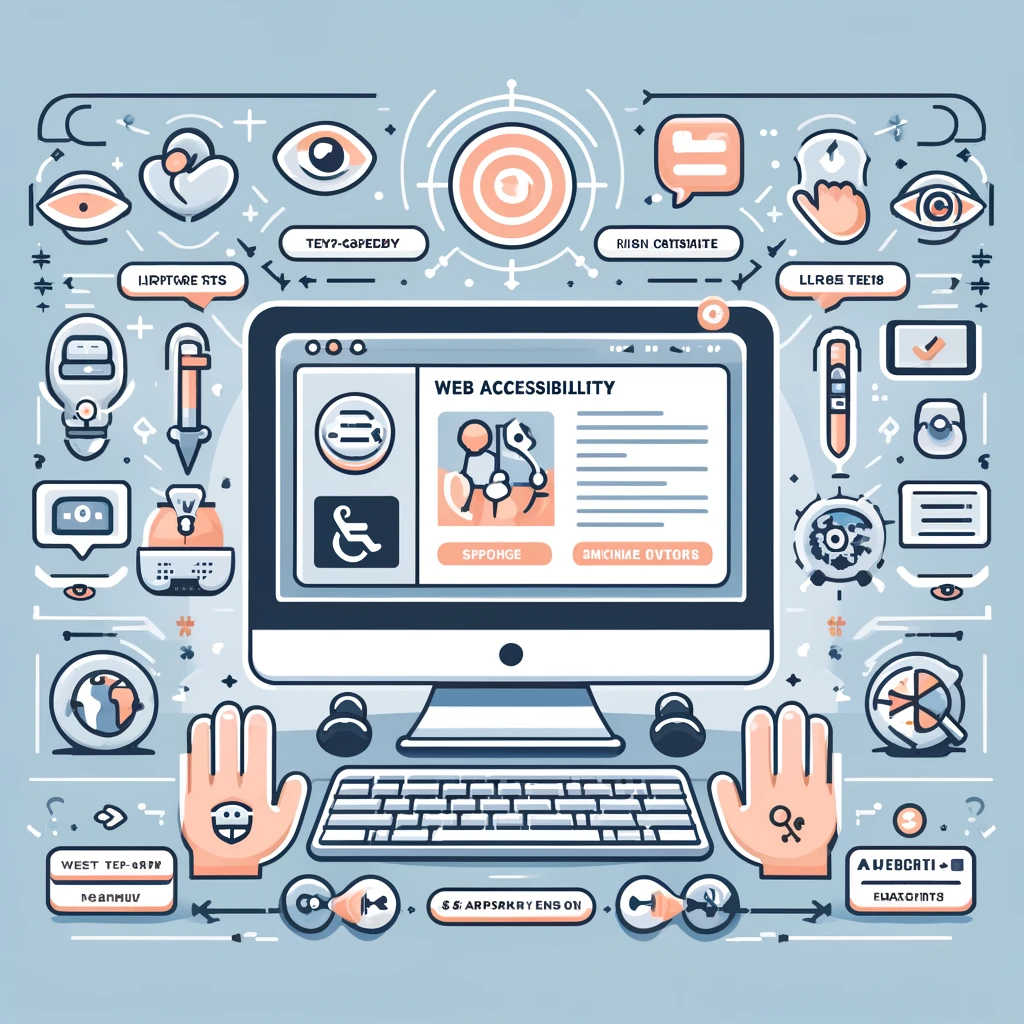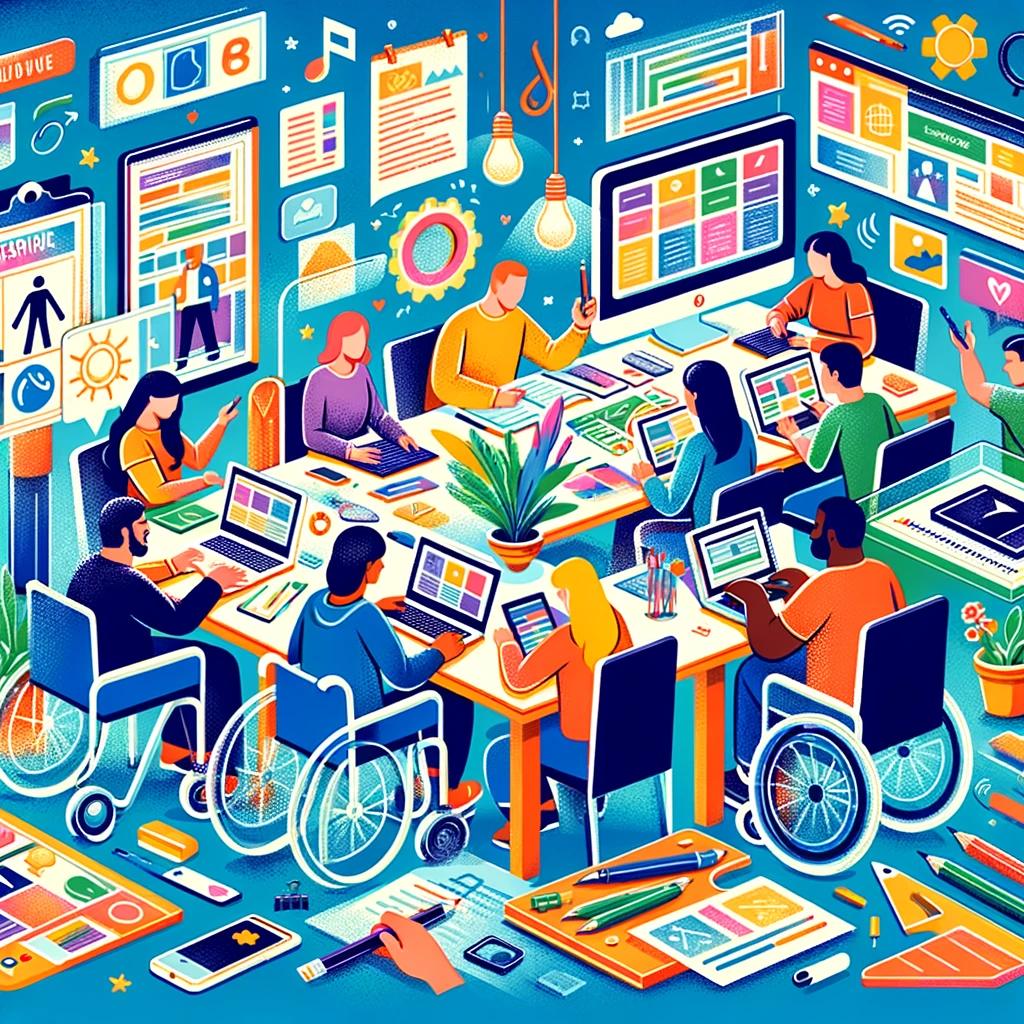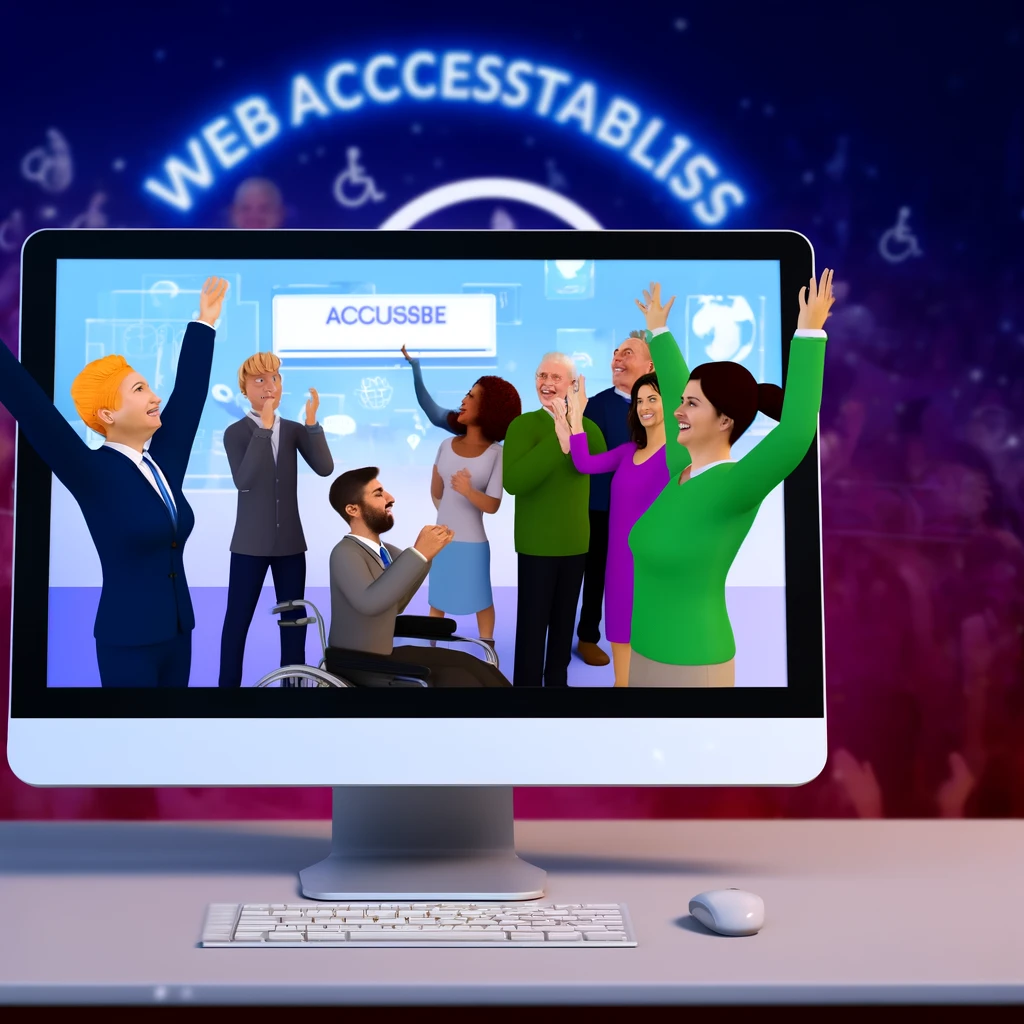Introduction

Welcome to the world of web accessibility—a crucial facet of digital design that ensures everyone, including people with disabilities, can use and benefit from your website. For businesses in Columbia and beyond, making your online presence accessible isn’t just a good practice; it’s a pathway to a more inclusive, ethical, and potentially more successful business.
Why Does Web Accessibility Matter?
- Inclusivity: Accessible web design allows individuals with disabilities—including vision and hearing impairments, mobility issues, and cognitive disabilities—to navigate, understand, and interact with your website.
- Legal Compliance: Many countries have laws and regulations requiring digital accessibility, and adhering to these can help you avoid legal issues.
- Broader Reach: By making your site accessible, you expand your potential audience dramatically, reaching more users who might need your services or products.
Accessibility is not a niche requirement but a fundamental aspect of effective web design. It supports social inclusion for people with disabilities, including the aging population, and enhances SEO efforts, improving your site’s visibility and operation.
Key Components of Web Accessibility:
- Visual: Ensuring your website is navigable and readable by users with visual impairments.
- Auditory: Providing alternatives for content that is typically delivered through sound.
- Physical: Making sure that all functionalities are accessible via keyboard or through other assistive technologies, not just a mouse.
- Cognitive: Designing clear interfaces and logical navigation to aid users with cognitive challenges.
As we dive deeper into this blog, we’ll explore how to assess your current website for accessibility barriers, practical design tips to enhance usability, and strategies for developing and maintaining an inclusive online environment. This isn’t just about technology—it’s about opening up your digital doors to everyone, and reaping the ethical and commercial benefits that follow.
Understanding Web Accessibility

Web accessibility is about enabling all users, regardless of their physical or cognitive abilities, to access and use websites effectively. It’s about creating an online environment that accommodates everyone’s needs, ensuring that digital content, features, and functionalities are accessible to people with a wide range of disabilities. This includes those with visual, auditory, motor, and cognitive impairments.
What is Web Accessibility? Web accessibility means that websites, tools, and technologies are designed and developed so that people with disabilities can use them. More specifically, people can:
- Perceive, understand, navigate, and interact with the web.
- Contribute to the web.
This inclusivity also benefits others, including older individuals with changing abilities due to aging, people with temporary injuries, or those in challenging environments where they cannot listen to audio or hold a mouse.
Core Principles of Web Accessibility (POUR): To remember the essentials of web accessibility, think of the acronym POUR, which stands for:
- Perceivable: Information and user interface components must be presentable to users in ways they can perceive (e.g., with visual, auditory, or tactile perception).
- Operable: User interface components and navigation must be operable by all users (e.g., through keyboard control, voice commands).
- Understandable: Information and the operation of the user interface must be understandable (e.g., clear instructions, predictable functions).
- Robust: Content must be robust enough to be interpreted by a wide variety of user agents, including assistive technologies.
Benefits of Embracing Web Accessibility:
- Reach a Wider Audience: Over a billion people worldwide have some form of disability. Making your website accessible expands your potential audience.
- Improve SEO: Many accessibility practices overlap with best practices for SEO, like providing alternative text for images and ensuring clear navigation.
- Enhance Usability: An accessible website generally provides a better user experience for all users, not just those with disabilities.
- Legal Compliance: Many regions have regulations requiring web accessibility, and non-compliance can result in legal repercussions.
Getting Started with Accessibility:
- Assess Your Current Site: Use tools like the Web Accessibility Evaluation Tool (WAVE) to identify areas for improvement.
- Educate Your Team: Ensure that everyone involved in web development understands the importance of accessibility and knows how to implement it.
- Implement Changes Gradually: Start with the most critical elements, such as text alternatives for non-text content and navigation accessibility.
Understanding and implementing web accessibility isn’t just a technical necessity; it’s a moral obligation and a business opportunity. By ensuring your website is accessible, you’re not only complying with legal standards but also committing to a philosophy of inclusivity and equal access for all.
Key Web Accessibility Standards

Navigating the world of web accessibility can be complex, but understanding the key standards can simplify the process. These standards are not just guidelines but are often backed by law, making them essential for any business wanting to ensure their website is accessible to all users, including those with disabilities.
1. Web Content Accessibility Guidelines (WCAG) WCAG is developed through the W3C process in cooperation with individuals and organizations around the world. It aims to provide a single shared standard for web content accessibility that meets the needs of individuals, organizations, and governments internationally.
- WCAG 2.0/2.1: These are stable, referenceable technical standards. They have 12-13 guidelines organized under four principles: perceivable, operable, understandable, and robust (POUR). Each guideline has testable success criteria, which are graded A, AA, or AAA.
2. Americans with Disabilities Act (ADA) The ADA is a civil rights law that prohibits discrimination against individuals with disabilities in all areas of public life, including jobs, schools, transportation, and all public and private places that are open to the general public. The purpose of the law is to make sure that people with disabilities have the same rights and opportunities as everyone else.
- ADA Title III: This title speaks specifically to public accommodations and requires businesses to maintain accessible digital content and web interfaces.
3. Section 508 An amendment to the United States Workforce Rehabilitation Act of 1973, Section 508 requires federal agencies to make their electronic and information technology accessible to people with disabilities.
- 508 Standards: These standards are aligned with WCAG 2.0 and ensure that federal websites have comparable accessibility for users with disabilities.
Table of Global Impact and Compliance Needs:
| Standard | Description | Compliance Level | Global Impact |
|---|---|---|---|
| WCAG | International guidelines for web accessibility. | Must comply to various levels: A, AA, AAA. | Widely adopted by countries worldwide. |
| ADA | US law requiring accessibility. | Must ensure accessibility to avoid legal repercussions. | Primarily impacts US businesses but also influences global firms operating in the US. |
| Section 508 | Requires US federal electronic and IT to be accessible. | Mandatory for federal agencies and contractors. | Impacts US government entities and contractors. |
Why Comply?
- Legal Requirement: Non-compliance can result in hefty fines and legal action.
- Broader Market Reach: Accessible websites reach a wider audience, including the millions of people with disabilities.
- Enhanced User Experience: Accessible websites tend to be more navigable and user-friendly for all users.
Understanding and implementing these standards is not just about avoiding legal pitfalls; it’s about embracing the spirit of inclusivity. By ensuring your website meets these standards, you contribute to a more accessible and inclusive digital world.
Assessing Your Current Website Accessibility

Evaluating your website’s accessibility is a crucial step in ensuring it is usable by everyone, including people with disabilities. This assessment helps identify barriers that might prevent people from fully accessing your site’s content and functionalities. Let’s dive into how you can assess your website’s accessibility effectively.
Step-by-Step Guide to Accessibility Assessment:
- Automated Testing Tools: Use automated tools to scan your website for common accessibility issues. These tools can quickly identify problems like missing alt text for images, poor color contrast, and lack of keyboard navigability. Examples include WAVE, AXE, and Google Lighthouse.
- Manual Testing: While automated tools are helpful, they can’t catch everything. Manual testing involves navigating your site using only a keyboard, testing with screen readers, and checking for logical order and meaningful sequences.
- User Testing: Involve real users, particularly those with disabilities, to test your website. They can provide invaluable insights into the user experience that automated and manual testing might miss.
- Consult WCAG Guidelines: Cross-reference your findings with the Web Content Accessibility Guidelines (WCAG) to ensure your site meets the specified success criteria.
Common Accessibility Issues and How to Identify Them:
| Issue | How to Identify | Tool Suggestion |
|---|---|---|
| Missing Alt Text | Automated tools can detect missing alt attributes on images. | WAVE, AXE |
| Poor Color Contrast | Tools measure text and background color contrast ratios. | WebAIM Contrast Checker |
| Non-Keyboard Accessibility | Try navigating your site using only a keyboard. | Manual testing |
| Inaccessible Forms | Check if form fields are properly labeled and accessible. | Manual testing, WAVE |
Creating an Accessibility Report: Once your assessment is complete, compile an accessibility report that includes:
- Identified Issues: List all the accessibility barriers found.
- Severity: Rate the impact of each issue on the user experience.
- Recommendations: Provide solutions for each identified problem.
- Timeline: Suggest a timeline for addressing these issues.
Why It Matters:
- Inclusivity: An accessible website ensures that all potential users, including those with disabilities, can engage with your content.
- Legal Compliance: Many regions require web accessibility by law; failing to comply can lead to penalties.
- Improved Usability: Accessibility improvements often enhance the overall usability of the site for all users.
By conducting a thorough assessment of your website’s accessibility, you not only comply with legal standards but also open your digital doors wider, ensuring that everyone can access your services or products without barriers. This commitment to accessibility reflects your brand’s values and dedication to inclusivity.
Designing for Accessibility

Designing for accessibility means creating a website that everyone can use, regardless of their physical or cognitive abilities. It’s not just about compliance; it’s about crafting an inclusive digital space that welcomes all users. Here’s how you can integrate accessibility into your web design process effectively.
Key Principles of Accessible Design:
- Simplicity: Keep your interface simple and intuitive. Complex designs can be confusing and difficult to navigate, especially for users with cognitive disabilities.
- Consistency: Use consistent navigation and page layouts throughout your site. This predictability helps users with cognitive and learning disabilities.
- Colors and Contrast: Ensure that text stands out against the background. High contrast helps those with visual impairments.
- Text Size and Legibility: Use fonts that are easy to read and make sure users can resize text without breaking the site layout.
Accessibility Features to Implement:
- Keyboard Navigation: Ensure all interactive elements are accessible with a keyboard.
- Alt Text for Images: Provide descriptive alt text for all images. This helps users who rely on screen readers.
- Aria Labels: Use ARIA (Accessible Rich Internet Applications) labels to enhance content description for screen readers.
- Forms and Inputs: Label all form inputs clearly and provide error messages that help users correct mistakes.
Table of Design Considerations:
| Element | Consideration | Why It Matters |
|---|---|---|
| Navigation | Logical, easy to use | Helps users find what they need quickly without frustration. |
| Headings | Clear hierarchy, descriptive titles | Organizes content logically for screen readers. |
| Buttons | Descriptive, large enough | Ensures they are easy to click and understand. |
| Videos | Subtitles, transcripts | Makes audio and video accessible to those with hearing impairments. |
Designing with Accessibility Tools:
- Color Contrast Analyzers: Tools like WebAIM’s Contrast Checker ensure your color choices have sufficient contrast.
- Responsive Design Testers: Check that your site is usable on all devices, which is especially crucial for users with limited dexterity.
- Accessibility Audits: Regular audits with tools like Lighthouse in Chrome can help identify and rectify accessibility issues.
Creating Inclusive Content:
- Descriptive Link Text: Avoid “click here” links. Use descriptive text that makes sense out of context.
- Logical Structure: Use proper HTML tags like
<h1>through<h6>for headings to structure your content logically.
By integrating these principles and features into your web design process, you ensure that your website is not only compliant with accessibility standards but also offers a superior user experience for all visitors. This approach not only broadens your audience but also reflects positively on your brand’s values and commitment to inclusivity.
Developing Accessible Content

Creating content that’s accessible to all users, including those with disabilities, is an essential aspect of web accessibility. It’s not just about compliance; it’s about crafting experiences that are enjoyable and useful for everyone. Let’s explore some key practices and strategies for developing content that everyone can access and appreciate.
Key Considerations for Accessible Content:
- Clarity and Simplicity: Use clear and simple language to ensure that your content is understandable by audiences with diverse abilities.
- Structured Content: Organize content logically using headings, lists, and clear sections, which helps those using screen readers to navigate your content more easily.
- Alternative Text: Provide alt text for all images, which describes the image content or function, aiding those who can’t see the images.
- Captions and Transcripts: Include captions for videos and transcripts for audio content, which are essential for users who are deaf or hard of hearing.
Table of Accessible Content Strategies:
| Content Type | Accessibility Feature | Description |
|---|---|---|
| Images | Alternative Text | Descriptive text for images, visible to screen readers. |
| Videos | Captions and Audio Descriptions | Text descriptions of audio content, and descriptions of visual elements for those who cannot see them. |
| Documents | Accessible PDFs or Word Docs | Ensure documents are readable by screen readers and can be navigated with a keyboard. |
| Audio | Transcripts | Written versions of audio content for those who are deaf or hard of hearing. |
| Infographics | Text Description | Provide a detailed text description for data visualizations. |
Creating Inclusive Content:
- Engage with Your Audience: Regularly seek feedback from users with disabilities to find out how accessible your content is and where improvements can be made.
- Use Accessibility Tools: Tools like Microsoft Accessibility Checker and Adobe Acrobat’s Accessibility Checker can help ensure your content meets accessibility standards.
- Continuous Learning: Stay updated on the latest accessibility guidelines and technologies. Web accessibility is a dynamic field that continues to evolve.
Benefits of Accessible Content:
- Broader Reach: Accessible content reaches a wider audience, including the millions of people with disabilities around the world.
- Improved SEO: Many accessibility practices, such as providing alt text for images and using clear headings, also improve SEO.
- Enhanced User Experience: Accessible content often results in a better user experience for all users, not just those with disabilities.
By integrating these practices into your content development process, you ensure that your website is not only accessible but also more engaging and useful to a broader audience. Developing content with accessibility in mind reflects a commitment to inclusivity and respect for all users, setting your website apart as a leader in user experience and social responsibility.
Testing and Maintaining Accessibility

Ensuring your website remains accessible is an ongoing commitment. It’s not enough to set it and forget it; you must actively test and update your site to maintain its accessibility. This process involves both automated tools and human insight to ensure that as technologies and content change, accessibility remains a priority.
Why Regular Testing and Maintenance Matter:
- Technological Changes: Web technologies and standards are constantly evolving. Regular testing ensures your site keeps up with these changes without losing accessibility.
- Content Updates: As new content is added to your site, it needs to be evaluated for accessibility to ensure it meets the required standards.
- User Feedback: Engaging with users, especially those with disabilities, can provide valuable insights into how accessible your site actually is.
Testing Your Website for Accessibility:
- Automated Testing Tools: Tools like WAVE, Axe, and Google Lighthouse can quickly identify many common accessibility issues.
- Manual Testing: This includes navigating your site using only a keyboard, using screen readers, and checking color contrast manually.
- User Testing: Nothing beats real user feedback. Conducting user testing sessions with people who have disabilities can help uncover issues that automated tools might miss.
Table of Accessibility Testing Methods:
| Testing Method | Description | Benefits |
|---|---|---|
| Automated Testing | Uses software tools to find common accessibility issues. | Quick and can cover large parts of your site quickly. |
| Manual Testing | Involves manually checking the site for accessibility guidelines compliance. | Catches issues that automated tools can miss. |
| User Testing | Real users with disabilities test the site for usability. | Provides direct feedback on user experience. |
Maintaining Accessibility:
- Regular Reviews: Schedule regular reviews of your site’s accessibility. This could be monthly, quarterly, or in line with major updates.
- Stay Informed: Keep up with changes in accessibility standards and web technologies to ensure your site remains compliant.
- Incorporate Feedback: Actively seek and incorporate feedback from users about how to improve the site’s accessibility.
Challenges and Solutions:
- Keeping Up with Changes: As web technologies evolve, maintaining accessibility can be challenging. Regular training and updates for your web team are essential.
- Integrating Accessibility into Updates: Ensure that any new content or functionality is accessible from the start. This requires that all team members are trained in accessibility best practices.
By implementing a robust testing and maintenance plan, you ensure that accessibility is not just an afterthought but a fundamental aspect of your website’s design and functionality. This ongoing commitment not only enhances the user experience for all but also protects your business from potential legal issues and broadens your audience reach, making your website a welcoming place for everyone.
Conclusion

Congratulations on embarking on the essential journey to make your website accessible to all! By now, you’ve explored the why and how of web accessibility, from understanding its principles to implementing strategies that ensure your digital presence is inclusive. This isn’t just about meeting standards—it’s about opening your virtual doors to everyone and embodying the spirit of inclusivity.
Recap of Key Points:
- Understanding Accessibility: It’s crucial to know what makes a site accessible, including visual, auditory, motor, and cognitive aspects.
- Implementing Standards: Following guidelines like WCAG and adhering to laws like the ADA ensures that your site meets necessary compliance and best practices.
- Regular Testing: Ongoing assessments using automated tools, manual checks, and real user feedback are essential to maintain accessibility.
- Continuous Improvement: Accessibility is not a one-time task but a continuous effort that evolves with web technologies and standards.
Looking Ahead: As you continue to develop and refine your website, keep accessibility at the forefront of your decisions. This commitment not only enhances user experience but also expands your market reach and protects against legal risks. More importantly, it reflects your dedication to equality and respect for all users, regardless of their abilities.
The Path Forward:
- Stay Informed: Keep up with new developments in web accessibility standards and technologies.
- Engage with the Community: Join forums, attend workshops, and connect with experts to stay engaged with the latest in accessibility.
- Feedback Loop: Continuously gather and integrate feedback from users to improve and adapt your accessibility features.
By making your website accessible, you are not only following best practices but are also contributing to a more inclusive digital world. Here’s to creating online spaces that everyone can enjoy, benefit from, and feel welcomed into!